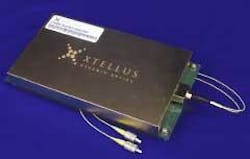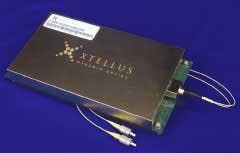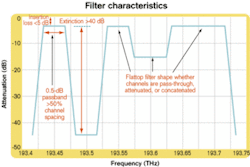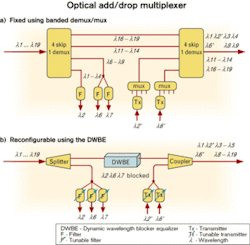Dynamic channels in reconfigurable optical networks
WDM technology and erbium-doped fiber amplifiers offered a clear path to an abundance of fiber-optic capacity for transmitting telecommunications traffic between two points. A single fiber can carry more than a terabit per second of traffic for thousands of kilometers purely in the optical domain, bringing the cost per transmitted bit virtually to zero.
The problem with this bounty of raw bandwidth is that there's still no effective way to reconfigure individual streams of optical traffic to dynamically route it in a timely manner. Reconfiguration occurs at two types of nodes in an optical network:
- Add/drop nodes are stations along the fiber route where wavelengths carrying local traffic get added to or dropped from the main traffic on the fiber.
- Crossconnect nodes are major terminals where multiple fibers meet and wavelengths are exchanged among the fibers.
Historical solutions for these nodes occupy two ends of the cost-performance spectrum. At one end, they're based on inexpensive fixed components that necessitate reconfiguration be performed manually, which is operationally inefficient and error-prone. At the other end, they're based on optical-electrical-optical (OEO) systems, which convert optical signals to and from the electrical domain. These systems are highly reconfigurable but carry a prohibitive price tag.
A powerful building block for implementing these nodes is emerging, dynamic wavelength blocker equalizer (DWBE) technology, which provides a high degree of reconfigurability in the optical domain for a moderate cost. This capability is most recently evidenced in the U.S. military's GIG BE project, which specifies add/drop and crossconnect nodes with DWBE functionality as the implementation vehicle.The DWBE is a two-port device that can dynamically pass, block, or equalize any or all wavelengths on a DWDM fiber under electronic control. The device is made up of a gold-plated optical module and an underlying electronic control board that together comprise a form factor of 220×110×30 mm (see Photo).
The device functions by dynamically controlling the filter shape for each wavelength (or channel) on a DWDM fiber. Typical filter characteristics are shown in Figure 1 for a portion of the spectrum for a device that supports 50-GHz spacing as per the ITU grid. Important parameters and features include:
- Low insertion loss to minimize consumption of link budgets.
- Flattop filter shape and wide passband to permit cascading multiple devices.
- Ability to attenuate wavelengths for power equalization purposes.
- High extinction ratio so remnants of blocked signals do not interfere with signals added to the same wavelength slots.
- Ability to concatenate several filters together to support passing bands of channels with mixed wavelength spacing schemes such as 25-, 50-, and 100-GHz spacing.
- Ability to be operated remotely under software control in real time to support wavelength provisioning and network restoration requirements.
What makes the DWBE an important technology is that it integrates multiple functions in a single module. To implement this functionality with discrete components would require a demultiplexer, an array of variable optical attenuators with blocking capabilities (up to 80 or more for long-haul applications), a multiplexer, and fiber and splicing to interconnect these elements. The DWBE offers advantages over a discrete approach: better optical performance with its low insertion loss and wide passband, a smaller form factor, and a lower price.
The DWBE is implemented using a core technology of a liquid-crystal spatial light modulator (LC SLM) in conjunction with free-space optics. By varying the control voltage to the LC SLM, the amount of light that passes through it can be controlled to pass, equalize, or block selected wavelengths.Liquid crystal has emerged as the technology of choice for DWBEs and is, in fact, the only technology commercially deployed for this purpose. Key advantages of liquid crystal are no moving parts, proven reliability, high optical power-handling capability, scalability to handle multiple wavelengths, and the ability to seamlessly concatenate adjacent pixels for continuous filter shapes. Other technologies contending to implement DWBE functionality include micro-electromechanical systems (MEMS) and planar lightwave circuits.
The simplest way to build an optical add/drop node is to drop wavelengths using a series of fixed three-port filters and add wavelengths using fixed-wavelength transmitters directly coupled to the fiber. (While the industry term for the node is "add/drop," in most implementations, the sequence of actions is to first drop wavelengths to free up slots, then add wavelengths to these slots.) The desired wavelengths to be dropped or added are pre-selected by network designers, then hard-engineered into each filter and transmitter. This type of node is simple to implement but onerous to reconfigure. Adding wavelengths requires ordering, then manually installing new filters and transmitters, which can take several weeks. Any reconfiguration also interrupts live traffic because the chain of add/drop elements must be opened.Figure 2. Fixed optical add/drop multiplexers (OADMs) use banded demultiplexers/multiplexers to provide a coarse granularity of wavelength access. Reconfiguration is manual and still relies on fixed components, but there is flexibility for dropping and adding within a band of wavelengths without interrupting service (a). In reconfigurable OADM implementations, the optical power is split between the through wavelengths that transit the dynamic wavelength blocker equalizer and those that are dropped and added (b).
Another scheme that provides greater flexibility uses two stages to drop and add wavelengths. The first stage uses banded demultiplexers/multiplexers to provide a coarse granularity of wavelength access. These multiplexers are generally of an N-skip-1 variety, where N channels are demultiplexed/multiplexed and one channel is lost to provide a broad guard band (see Figure 2a). Each band can then be individually accessed using filters, or multiplexers, to drop and add individual wavelengths. Reconfiguration is still manual and still relies on fixed components; however, there is flexibility for dropping and adding within a band of wavelengths without interrupting service. But if a new band of wavelengths nailed up between demultiplexer and multiplexer needs to be accessed, then live traffic interruption is likely. Another drawback of banding is that it leads to stranded and thus wasted wavelength slots.
The DWBE can add immediate value to this type of add/drop configuration using an arrangement called broadcast and select (see Figure 2b). Here the optical power is split between the through wavelengths that transit the DWBE and those that are dropped and added. That creates a "separation of concerns" that greatly simplifies network engineering.
By passing or blocking any channel at the DWBE module, there is flexibility for local demultiplexing, multiplexing, or filtering schemes to drop and add any individual wavelengths without service interruption or wavelength stranding. Wavelengths can be dropped and added using fixed components, or as shown in Figure 2b, tunable filters and tunable lasers can be used to achieve a totally reconfigurable optical add/drop multiplexer (ROADM) node.
The insertion loss in the ROADM configuration is about 11 dB, consisting of 3 dB for splitting and recombining optical power and 5 dB for the DWBE module. That is about the same as using a fixed back-to-back demultiplexer and multiplexer with a flattop passband, so the DWBE does not add an insertion loss penalty. Moreover, the power can be split asymmetrically so as to provide lower insertion loss on the through path at the expense of slightly higher loss for the add/drop paths where lower power usually does not matter as much.
An additional benefit of the DWBE is its wavelength attenuation feature, which can be used to equalize optical power on the fiber. That can compensate for optical power variations caused by added and dropped wavelengths as well as for transmission degradations due to amplifier nonlinearities.
At an optical-crossconnect (OXC) node, wavelengths are exchanged among three or more fibers that meet at the node and sometimes local traffic is added and dropped. The most powerful method of implementing an OXC node is to use an OEO switch. This switch works by demultiplexing every wavelength from incoming fibers, converting the signals they carry into the electrical domain, bringing these signals to an electronic switch for processing, reconverting them to optical signals, then remultiplexing them onto outgoing fibers. By using an OEO switch to implement crossconnect-node capability, it is possible to reshape, retime, and reamplify each signal as well as perform wavelength conversion. The downside is OEO switching capabilities are extremely expensive. Moreover, using an OEO approach is "overkill' for wavelengths that simply need to transit the crossconnect node in the optical domain. Studies indicate that about 75% of crossconnect-node traffic can be handled in the optical domain without electronic conversion.
The most basic way to implement an all-optical crossconnect without electronic conversion is to use demultiplexers and multiplexers to access individual wavelengths, then crossconnect desired wavelengths on a patch panel using fiber jumper cables (see Figure 3a). The shortcoming to this approach is it involves manually terminating and manipulating hundreds of individual fibers, one for each wavelength, so besides being cumbersome and error-prone, it is totally unsuitable for automated restoration or rerouting purposes.The initial method considered by the industry for implementing automated optical crossconnection was to use a photonic-switching fabric such as 3-D MEMS. But within the last year, most of these all-optical-switching initiatives have disappeared because they were too complex and costly for the provided benefits and many failed to prove their reliability. Photonic switches still required demultiplexing and multiplexing all the wavelengths; the manual arrangement and the costs of the switching fabrics remained very high. Moreover, they were engineered to deal with dozens of fibers coming together at a crossconnect node when in reality only three or four fibers typically meet.
Today, DWBE technology can be used to implement a highly efficient OXC for a moderate number of fibers. Only 12 DWBE modules are required to implement an OXC for four bidirectional fiber cables (see Figure 3b). When packaged in a system, that would consume less than a shelf in a 19-inch rack.
The key advantage of DWBE technology is it does not require any external multiplexers or demultiplexers since this functionality is embedded in the device. This capability greatly simplifies engineering of the crossconnect and minimizes the amount of fiber and splices needed to interconnect the various elements. Moreover, the DWBE can perform power equalization to adjust for different signal strengths of wavelengths on different fibers.
Another advantage of this technology is it enables a highly scalable architecture. An ROADM can be quickly upgraded to an OXC by simply adding DWBE modules, and the number of fiber terminations an OXC can handle can scale the same way.
From a price perspective, this approach to implementing an OXC is about half the cost of using an all-optical-switching fabric, and it is less than one-fourth the cost of an OEO switch with similar traffic-handling capacity. However, it cannot reshape, retime, and reamplify signals, and it cannot perform wavelength conversion. The ultimate goal for a crossconnect node is to marry a DWBE-based OXC with an OEO switch. Traffic can be handled all-optically or electronically based on need, and the cost-performance of the entire node can be optimized. That is the direction the industry is moving.
DWBE technology is emerging as a key building block for ROADM and OXC nodes. It is already in use in long-haul networks, and it is now being examined for metro architectures.
Jonathan Homa is vice president of business development at Xtellus. He can be reached at [email protected].




